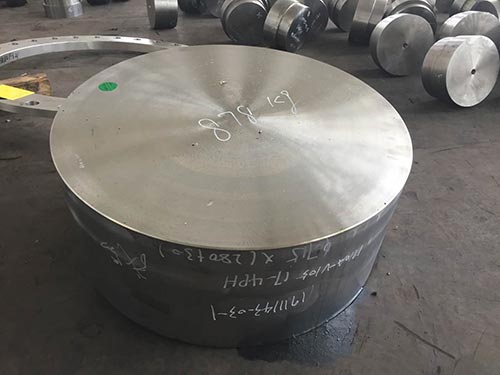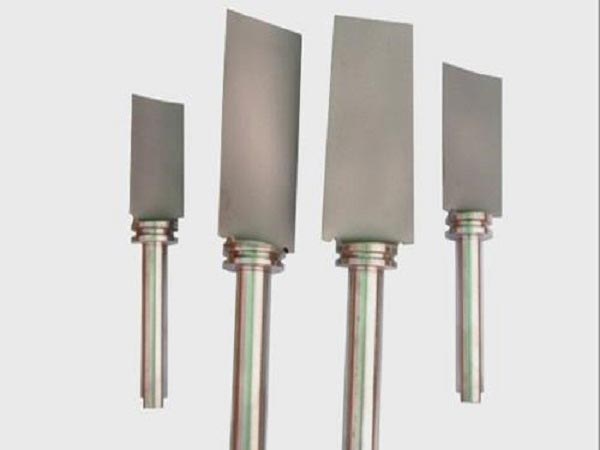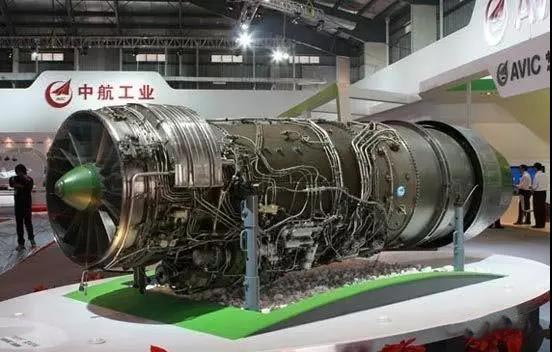Introduction of high-temperature alloy forgings:
High-temperature alloy forgings (superalloy) are mainly used to manufacture disks, rings, blades and other load-bearing parts of turbines, compressors and combustion chambers (including afterburners) of modern aero engines and gas turbines. Among them, the largest number of applications, the most important, and the worst working environment are turbine discs and compressor discs and blades. They are all forged from the alloy with the worst deformation properties among the complex alloying high-performance superalloys.
Fist:Superalloy disc-shaped parts and their characteristics
-
Superalloy aero-engine discs include turbine discs, bearing rings and high-pressure compressor discs. Turbine disk is a typical piece.
-
 Generally, aviation turbojet and turbofan engines use thrust-to-weight ratio (thrust/mass) to comprehensively assess their performance levels. The thrust-to-weight ratios of the second, third and fourth generation engines are 5-6, 7-8 and 9-10. The working temperature of the turbine disc is 600℃, 650℃ and 700℃. The materials used are deformed superalloy and high temperature powder For alloys, the corresponding forging processes are die forging process, isothermal forging or superplastic forging process and superplastic forging process of powder superalloy. The thrust-to-weight ratio of the V-generation engine is 15-20, the working temperature of the turbine disc is 780℃~950℃, the material used is dual performance (or dual alloy) powder superalloy or fiber reinforced superalloy, and the forging process is superplastic forging process Or hot isostatic pressing process.
Generally, aviation turbojet and turbofan engines use thrust-to-weight ratio (thrust/mass) to comprehensively assess their performance levels. The thrust-to-weight ratios of the second, third and fourth generation engines are 5-6, 7-8 and 9-10. The working temperature of the turbine disc is 600℃, 650℃ and 700℃. The materials used are deformed superalloy and high temperature powder For alloys, the corresponding forging processes are die forging process, isothermal forging or superplastic forging process and superplastic forging process of powder superalloy. The thrust-to-weight ratio of the V-generation engine is 15-20, the working temperature of the turbine disc is 780℃~950℃, the material used is dual performance (or dual alloy) powder superalloy or fiber reinforced superalloy, and the forging process is superplastic forging process Or hot isostatic pressing process. -
Turboshaft/turboprop engine adopts power-to-weight ratio to comprehensively assess its performance level, and its development trend is similar to that of turbojet and turbofan engines.
-
There are two main structural forms of turbine discs: large and medium-sized aeroengines mainly adopt a single disc structure; small aeroengines mainly adopt an integral blisk structure. The former is usually called “turbine disk” and the latter is called “integral turbine”. In addition, there are welded double-spoke discs.
1. The working environment of the turbine disc
Turbine disks have high working temperature, large changes, and complex stress states, which are key parts of turbine engines. The characteristics of its working environment are as follows:
-
Large heat load:Although the working temperature of the turbine disc is lower than that of the turbine blade, the temperature difference from the rim to the hub is large. When the engine is repeatedly started, accelerated and stopped, the temperature changes sharply, and the thermal expansion of each part is inconsistent, resulting in large thermal stress and thermal strain. As the working time increases, thermal fatigue and plastic deformation will occur.
-
Large centrifugal load:The turbine rotor rotates more than 10,000 revolutions per minute, and its own mass produces a large centrifugal force. The centrifugal force of the blades on the wheel is also transmitted to the disk. The superposition of the two causes extremely high radial force, which is easy to cause low cycle fatigue and disk. Body elongation.
-
Large vibration load:During the working process of the engine, due to the combined effect of aerodynamic force and interference force, various types of vibrations are generated in the turbine disc.
2. Basic requirements for turbine disc materials and forgings
The superposition of thermal stress, centrifugal stress and vibration stress makes the stress state of the turbine disk very complicated and the working environment is extremely harsh. Therefore, the following extremely high requirements are put forward for turbine disc materials and forgings:
-
It shall have long-term stable high tensile strength, high yield strength and high fatigue resistance in a wide operating temperature range;
-
High specific strength (including endurance strength), high creep strength and plasticity at high temperature;
-
The material should have low linear expansion coefficient, high thermal conductivity, low notch sensitivity and low crack growth rate;
-
The material should have excellent oxidation resistance and corrosion resistance;
-
The grain structure should be uniform, and the streamline should be distributed along the shape of the forging;
-
The material cost, the scrap rate and cost of forgings should be low.
3. Production status of turbine disc forgings
-
 As mentioned above, the working conditions of the turbine disc are harsh, so the quality of forgings is extremely high, and it is one of the most important parts of the gas turbine engine. Usually, if the turbine disk fails, a first-class accident will occur. In the classification of aviation engine parts according to importance, they are key parts. Therefore, we attach great importance to the quality of turbine disks. Turbine disk forgings are produced using high-quality materials and advanced forging processes. The relatively successful GH4169 (INCONEL 718) and GH4133B alloy turbine disk forgings produced in China are mainly forged with counter-hammers, and their working temperature is about 650℃. The turbine disc forgings with higher performance are being developed.
As mentioned above, the working conditions of the turbine disc are harsh, so the quality of forgings is extremely high, and it is one of the most important parts of the gas turbine engine. Usually, if the turbine disk fails, a first-class accident will occur. In the classification of aviation engine parts according to importance, they are key parts. Therefore, we attach great importance to the quality of turbine disks. Turbine disk forgings are produced using high-quality materials and advanced forging processes. The relatively successful GH4169 (INCONEL 718) and GH4133B alloy turbine disk forgings produced in China are mainly forged with counter-hammers, and their working temperature is about 650℃. The turbine disc forgings with higher performance are being developed. -
Europe and the United States have adopted advanced smelting and forging processes to mass produce high-performance turbine disk forgings made of complex alloyed superalloys. The operating temperature has reached 700°C to 800°C and has been widely used. The manufacturing process of dual-performance turbine discs with higher service temperature and different structures and properties of rims and spokes is being developed. For example, the United States has produced IN100, DTP IN100 and Rene’88DT powder high-temperature alloy forgings using isothermal superplastic vacuum forging technology (Gatorizing); Russia has adopted patented technologies such as multiple vacuum melting, diffusion annealing, extrusion blooming, and sheath die forging. Mass production of ЭИ698, ЭΠ742, ЭК79 and ЭΠ741ΗΠ alloy turbine disk forgings.
-
Forging technology of these complex alloyed superalloys and their turbine discs are patents, and the technical details have not been disclosed in the literature. For example, in the 1996 edition of the Russian Aerospace Materials Handbook, ЭИ698, ЭΠ742, ЭК79, ЭΠ741У, ЭΠ741Π and ЭΠ741ΗΠ and other turbine disk alloys, such as the chemical composition, physical properties, mechanical properties, corrosion resistance, heat treatment, welding and cutting process data should be all Only there is no forging process data, but other deformed superalloys have more detailed forging process data.
-
It is worth pointing out that the above-mentioned high-performance turbine discs and their advanced forging technologies generally use numerical simulation techniques to determine forging process parameters.
Second.:Superalloy blades and their characteristics
-
High-temperature alloy blades are mainly used for high-pressure and low-pressure turbines of turbine engines and rotor blades of high-pressure compressors. Among them, the working environment of turbine rotor blades (or turbine working blades) is the worst. According to the structure and shape, the turbine blades can be divided into two types: crowned blades and crownless blades.
-
 Turbine blades are mostly crownless blades, which generally consist of a blade body, a root segment and a tenon. The crowned working blades have one more leaf crown at the tip than the uncrowned working blades. The cross-sectional area of the tenon of the turbine blade is larger, and the cross-sectional area of the blade crown is larger than that of the blade body. The blade body has a curved cross-section and uneven thickness. The longitudinal section has a large twist angle and a large thickness variation. The root section of the tenon is the transition section from the blade body to the tenon, which is connected by a circular arc and has a large cross section.
Turbine blades are mostly crownless blades, which generally consist of a blade body, a root segment and a tenon. The crowned working blades have one more leaf crown at the tip than the uncrowned working blades. The cross-sectional area of the tenon of the turbine blade is larger, and the cross-sectional area of the blade crown is larger than that of the blade body. The blade body has a curved cross-section and uneven thickness. The longitudinal section has a large twist angle and a large thickness variation. The root section of the tenon is the transition section from the blade body to the tenon, which is connected by a circular arc and has a large cross section. -
Generally, among the deformed superalloys used in the same engine, the turbine blade material is always the alloy with the highest degree of alloying and the highest performance level, and it is also the superalloy with the worst plasticity.
-
Due to the poor plasticity of the turbine blade material, the large deformation resistance, and the very complicated shape of the blade, it is undoubtedly difficult to forge the turbine blade.
1. Working environment of turbine blades
-
The turbine blade is one of the most critical parts of the turbine engine. During the working process of the engine, the working environment of the turbine blades is the worst. They mainly bear the bending stress, centrifugal stress and vibration stress of aerodynamic stress. At the same time, they also bear the corrosion effects of high temperature, thermal shock and gas.
2. Requirements for die forgings of turbine blades
-
The superposition of thermal stress, centrifugal stress, bending stress and vibration stress makes the stress state of turbine blades very complicated and the working environment is extremely harsh. In order to ensure its safe and reliable work, the following extremely high quality requirements are put forward for turbine blade materials and forgings:
-
Turbine blade forgings work under extremely high temperature and stress conditions, so it is required to have sufficiently high thermal strength (such as high temperature tensile strength, creep and permanent fracture strength) and good overall performance, including high cycle And low cycle fatigue strength, thermal fatigue performance, high temperature plasticity and impact toughness, etc., without notch sensitivity;
-
It should have the highest possible high temperature oxidation resistance and gas corrosion resistance;
-
Turbine blade materials have low linear expansion coefficient and high thermal conductivity;
-
It should have long-term organizational stability;
-
The grain structure of the blade forgings is uniform and the streamlines should be distributed along the longitudinal direction of the blade;
-
Turbine blade materials should have good process performance, with low scrap rate and low cost for forging production.
3. Production of turbine blade die forgings
-
https://hynickelalloy.com/wp-content/uploads/2018/11/Domestically-made-new-WS-15-military-aviation-engine-using-rhenium-single-crystal-blades.jpg
 It can be seen from the history of the development of deformed superalloys for turbine blades in China that the early aero-engine turbine working blades were all deformed superalloys; among them, nickel-based alloys such as GH4033, GH4037 and GH4049 were the most used. The forging process of turbine blades in China is as follows: hot-rolled bars are ground externally, ultrasonically inspected, blade root heads are upset by flat forging machines, blade shaft cones are turned, mechanical presses are pre-forged and final forged into blade molds Forgings. Since the box-type electric furnace is generally used for forging heating, in order to avoid leaving the alloy element depleted layer formed during the forging heating process on the blade parts, the margin of the blade forgings is mostly controlled in the range of 2.5mm to 3.5mm.
It can be seen from the history of the development of deformed superalloys for turbine blades in China that the early aero-engine turbine working blades were all deformed superalloys; among them, nickel-based alloys such as GH4033, GH4037 and GH4049 were the most used. The forging process of turbine blades in China is as follows: hot-rolled bars are ground externally, ultrasonically inspected, blade root heads are upset by flat forging machines, blade shaft cones are turned, mechanical presses are pre-forged and final forged into blade molds Forgings. Since the box-type electric furnace is generally used for forging heating, in order to avoid leaving the alloy element depleted layer formed during the forging heating process on the blade parts, the margin of the blade forgings is mostly controlled in the range of 2.5mm to 3.5mm. -
As the thrust-to-weight ratio and power-to-weight ratio of aeroengines increase, the inlet temperature of the engine turbine is getting higher and higher, and the temperature-bearing capacity of the turbine working blades is required to be higher and higher. At present, the use temperature of nickel-based superalloys is close to the limit. If you want to increase the inlet temperature of the engine turbine, air-cooled hollow blades must be used to reduce the actual temperature of the blades themselves. However, the process of forging hollow blades is very complicated, the production cycle is long, and the price is expensive. Therefore, cast hollow blades have been used to replace forged solid blades in the high pressure Ⅰ turbine blades of modern aeroengines; however, some high pressure Ⅱ turbine blades and low pressure turbines Forged blades are still used for rotor blades and high-pressure compressor blades. In addition, forged turbine blades are also used in ground gas turbine engines. Therefore, turbine blades made of deformed superalloys still have broad application prospects.

